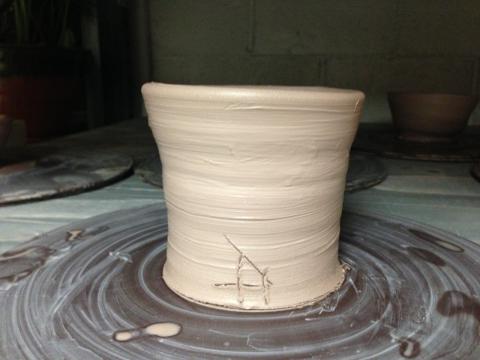
After just one pottery class, I've decided that there are many similarities between throwing pots and writing stories. Both are addictive. Both take a lot of practice time and effort to become accomplished. The end result, when done well, is engaging on many levels. There are, however, some significant advantages when learning the craft of clay versus that of writing.
Catastrophic failure One of the real advantages of working in clay is that when you don't know what you're doing and you do something wrong, it's generally immediately obvious. Rather than a nice cylinder sitting on your wheel, all of a sudden you have ribbons of clay flinging around and there's nothing to do but start over. Since most of us learn to speak at a very young age, it's easy to believe that our first poorly constructed paragraphs soar like fine literature. It takes kind encouragement to get us to recognize our mistakes and want to improve upon our first take. It took me a long time as a writer to understand what my story was lacking when someone praised it for being a good first draft. Hell, I'd rewritten the damn thing multiple times by then, and the grammar was spotless! When you watch a half-formed lump of clay collapse, you may not know what you did wrong, but you certainly know you've missed something.
Rejects When you start throwing pots, there's a pretty clear assumption that it's going to take practice and that you're going to make a ton of less-than-perfect objects before you develop enough skill to produce a consistent product. As writers, we want everyone of our darlings to see the light of day. It's not enough to give away your first efforts to your loving relatives as Christmas presents. In fact, unless your relatives really, really love you, you might not want to let them see anything you've written.
It's a craft No one questions that working with clay is a craft. Very good clay workers are called artisans. Those who take the humble shape of a pot and imbue it with meaning are artists. The same is true for writing, except that people tend to want to step over the craft aspect on their way to the art. Maybe you are an artist. Don't let poorly executed craftsmanship disguise your art.
Note: The pot illustrated here is one of four from my first class. It's a humble but reasonably acceptable example of two hours work in a new media. This should not be confused with the terra cotta pot I used to illustrate the Spontaneous post. That is a pot I crafted in a 3D rendering program and is built from pixels, not clay.
- Log in to post comments
